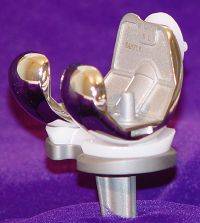The unicondylar design is for replacement for either the medial or the lateral femoral tibial articulation. It is designed to allow 120 degrees of flexion. The vitallium femoral component is curved in both the coronal and sagittal planes, mimicking the normal femoral condyle. Because of the design, both right and left prostheses are available. Fixation is by a central pin and a small anterior flange. The tibial component, of high-density polyethylene, has a medial prominence and matches the curve of the femoral component in the coronal plane and it is flat in the sagittal plane. The deep surface is dovetailed for fixation to the tibia. There are three thicknesses: 5/16 of an inch (7.9 millimeters), 3/8 of an inch (9.5 millimeters), and 1/2 inch (12.7 millimeters) and the implant available in a variety of sizes.
The unicondylarprosthesis is used mostly for compartmental osteoarthritis on one side of the knee. The principle behind the choice of unicondylar replacement is that osteoarthritis of the knee is usually compartmental and resulting deformity is caused by loss of bone substance. Thus, alignment can be restored by building up one side of the joint. This limited replacement might come closest to restoring normal joint function [4].
Unicondylar Implant [12]
Implanted Unicondylar Implant [13]
The femoral component of the duocondylar prosthesis is similar in shape to that of the unicondylar model except that there is no anterior flange and instead the halves are connected by an anterior cross bar which is countersunk during insertion. The two separate tibial components are identical to those used for the unicondylar prosthesis and are aligned for insertion with a jig. The cruciate ligaments are preserved when this prosthesis is used. Flexion of 120 degrees is allowed. A variety of sizes are available to meet the patient’s anatomy.
The duocondylar prosthesis is generally used for rheumatoid panarthritis and in osteoarthritis. Because of its anatomical shape, a duocondylar implant is most suitable when deformity, instability, and flexion contracture are not too severe [4].
Duocondylar Implant [12]
Duocondylar Implant Implanted [13]
In this configuration, the polyethylene insert can rotate slightly, which gives knee implant a more natural interface between the surface of femoral component and polyethylene. Both gliding and rotation motions of the knee can be accomplished. Since the polyethylene can rotate, contact with the femoral component is even less, resulting in less stresses and wear [5]. Although wear and stresses are lessened, dislocation may be of concern [3].

Mobile Bearing Implant [12]